Chief Post Office, Christchurch
The Chief Post Office or Christchurch Central Post Office, originally known as the Government Building, is located in Cathedral Square, Christchurch, New Zealand. The building was initially a post office with other government services. Until the 2011 Christchurch earthquake, it was a Visitor Information Centre but has since been inaccessible, as access for the public to the central city has been removed. It was the site of the first telephone exchange in New Zealand. The structure is registered with Heritage New Zealand as a Category I heritage building.
| Chief Post Office | |
|---|---|
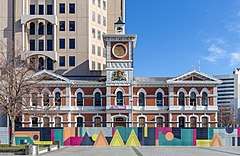 The former Chief Post Office after the 2010 Canterbury earthquake (photo from 2019) | |
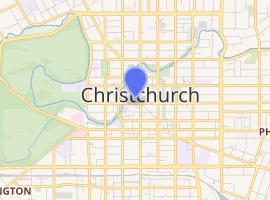
| |
| General information | |
| Type | Government, with some commercial enterprises |
| Architectural style | Italianate style with classical and Venetian Gothic elements |
| Location | Cathedral Square, Christchurch Central City |
| Address | 31 Cathedral Square |
| Town or city | Christchurch |
| Country | New Zealand |
| Coordinates | 43.5316°S 172.6358°E |
| Current tenants | Christchurch Visitor Information Starbucks |
| Construction started | 24 May 1877 |
| Completed | 1878 |
| Renovated | 1907 |
| Owner | Chrystal Imports |
| Technical details | |
| Floor count | two |
| Design and construction | |
| Architect | William Henry Clayton |
| Main contractor | Daniel Reese |
| Designated | 2 April 1985 |
| Reference no. | 291 |
| References | |
| "Chief Post Office (Former)". Register of Historic Places. Heritage New Zealand. | |
Geography
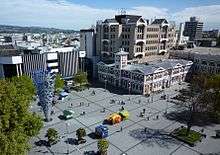
The building is located at 31 Cathedral Square,[1] and is situated in the Square's southwest corner.[2] Footpaths and a cabstand were added after the post office opened.[3] During the 1992 redesign and redevelopment process of the Square, the road in front of the former Chief Post Office was closed.[3]
History
In 1863, the New Zealand House of Representatives noted an important change was to take place in Canterbury, in that Christchurch would replace Lyttelton as the principal post town.[4] The General Government was renting several government buildings in Canterbury, some of which were inconveniently situated or badly constructed.[5] Christchurch's first post office was very small, and located at Market Square, these days known as Victoria Square.[6]
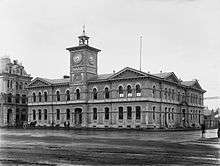
The Canterbury Provincial Council, with the sanction of the General Government, agreed to erect government buildings in Cathedral Square, opposite the Anglican Church's building site. A Bill passed in 1873 vested the site in the Crown. Plans were drawn by William Henry Clayton,[7][8] the first (and only) Colonial Architect to New Zealand.[9][10] Clayton had previously designed the (former) post office in Lyttelton, and that building, smaller but similar in style, is regarded as his "trial run" for the building in the Square.[7] While it was agreed that the new building should accommodate the General Government, opinions differed on whether the construction should be ornamental. A prevailing motion approved that some regard ought to be paid to a little architectural finish.[5]
The construction contract was awarded to Daniel Reese.[2] The foundation stone was laid by Hon Edward Richardson, a Christchurch member of parliament who until earlier in the year had been the first Minister of Public Works,[11] on Queen's Birthday on 24 May 1877. The event was poorly attended, partly because no programme had been arranged beforehand. In his speech, Richardson reflected on the lengthy delay of starting construction, owing to the controversy about the building site. The mayor, Fred Hobbs, then used his address to lobby the attending members of parliament for a Resident Magistrate's Court (which was built in 1880/81[12]). Since nobody came forward to speak afterwards, the crowd dispersed. Attendees of the ceremony were Bishop Harper, MHR William Rolleston, MHR Edward Stevens and MHR William Montgomery.[13][14]
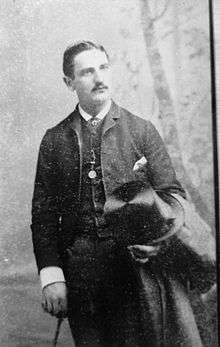
Soon after laying the foundation stone, Clayton died and the work was supervised by his assistant Pierre Finch Martineau Burrows.[6] The building was completed in 1878. It opened behind schedule on 14 July 1879.[2]
The building originally housed the postal department as well as other Government and administration offices. In 1881, New Zealand's first telephone exchange was installed in the building.[6] The building was extended in 1907 to the west by adding a third gable; up until that point, it had two symmetrical façades. The extension was designed and supervised by Burrows.[6] When the new Government Building opened at the eastern end of the Square in 1913, the postal services remained and the building became known as the Chief Post Office.[7]
In the 1930s, the post office was threatened by demolition, as more space was required. Construction of a new post office didn't start until 1989, immediately to the south of the existing building. The seven-storey building dominates and impairs the historic structure, and parts of the old building had to be demolished to make way for the high rise.[6][7]
The building suffered minimal damage in the 2010 Canterbury earthquake, and only minor damage in the February 2011 Christchurch earthquake. The landlord, Gordon Chamberlain, director of Chrystal Imports, fears that necessary repair to or demolition of nearby high-rise buildings will restrict access to his buildings for "years".[15] Of the four other central city buildings owned by Chrystal Imports, at least two will probably have to be demolished, including Warner's Hotel on the opposite side of the Square.[16]
These days, the Chief Post Office serves as the main Information and Visitors Centre (previously located at what is now Our City), has Starbucks as a ground floor tenant, and provides some office space on the upper floor.[17]
Architecture and fittings
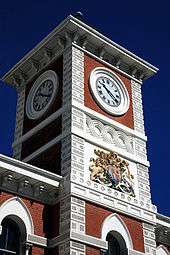
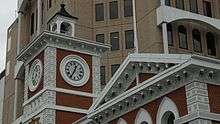
Built of brick, the design is Italianate style with classical and Venetian Gothic elements. The upper windows feature pointed arches. A later renovation brought a third gabled bay to the north frontage.[6] The building is registered with the New Zealand Historic Places Trust as a Category I heritage item, with the registration number 291.[6]
- Clock
Reputed to be a replica of London's Great Clock of Westminster,[2][18] a working, free standing, four faced turret clock was installed in 1879 within a clock tower.[19] Underneath the east facing clock face is the Royal coat of arms of the United Kingdom.[6] Notable for being unreliable, an electric clock was eventually installed to control the visible faces as slave clocks. While at one time it chimed on the hour and at the quarters,[20] after the mechanisms were damaged in a 1980s fire, the clock became silent.[2]
References
- "Chief Post Office (Former)". zenbu.co.nz. Retrieved 16 May 2011.
- "The Chief Post Office". Christchurch City Council handbook. Christchurch City Libraries. 1998. Retrieved 16 May 2011.
- "The Squares of Christchurch". Christchurch City Libraries. Retrieved 16 May 2011.
- New Zealand. Parliament. House of Representatives (1863). Appendix to the journals of the House of Representatives of New Zealand. pp. 4–. Retrieved 19 May 2011.
- New Zealand. Parliament. House of Representatives (1875). Parliamentary debates. s.n. pp. 564–565. Retrieved 19 May 2011.
- Lovell-Smith, Melanie (11 December 2001). "Chief Post Office (Former)". New Zealand Historic Places Trust Pouhere Taonga. Retrieved 16 May 2011.
- Wilson, John (2007). City and Peninsula : The Historic Places of Christchurch and Banks Peninsula. Christchurch: The Christchurch Civic Trust, The Akaroa Civic Trust. pp. 67, 132. ISBN 978-0-473-12239-3.
- "Christchurch Post Office". christchurchcitylibraries.com. Retrieved 16 May 2011.
- Crighton, Anna. "Clayton, William Henry – Biography". Dictionary of New Zealand Biography. Ministry for Culture and Heritage. Retrieved 4 April 2011.
- "History- Treaty Onwards". russellnz.co.nz. Archived from the original on 2 June 2010. Retrieved 16 May 2011.
- Scholefield, Guy (1950) [First ed. published 1913]. New Zealand Parliamentary Record, 1840–1949 (3rd ed.). Wellington: Govt. Printer. p. 36.
- "Magistrate's Court". Register of Historic Places. Heritage New Zealand.
- "Local and General". The Star (2852). 24 May 1877. p. 2. Retrieved 19 May 2011.
- "Christchurch". Manawatu Times. II (64). 30 May 1877. p. 2. Retrieved 19 May 2011.
- Heather, Ben (6 April 2011). "Quick fixes ruled out for ChCh buildings". The Press. Retrieved 19 May 2011.
- Heather, Ben (19 May 2011). "Landlords may be forced to sell at loss". The Press. p. A3.
- "Unlimited Paenga Tawhiti Historic Faces of Christchurch The Old Chief Post Office". Living Heritage. Retrieved 16 May 2011.
- "City Heritage Walks" (PDF). Christchurch City Council. p. 3. Retrieved 19 May 2011.
- "Chief Post Office Clock – Christchurch, New Zealand". waymarking.com. 4 November 2010. Retrieved 16 May 2011.
- Grundy, Elaine (1968). Who'd marry a doctor?: A Chatham Islands casebook. Whitcombe and Tombs. p. 12. Retrieved 19 May 2011.
External links
| Wikimedia Commons has media related to Chief Post Office, Christchurch. |